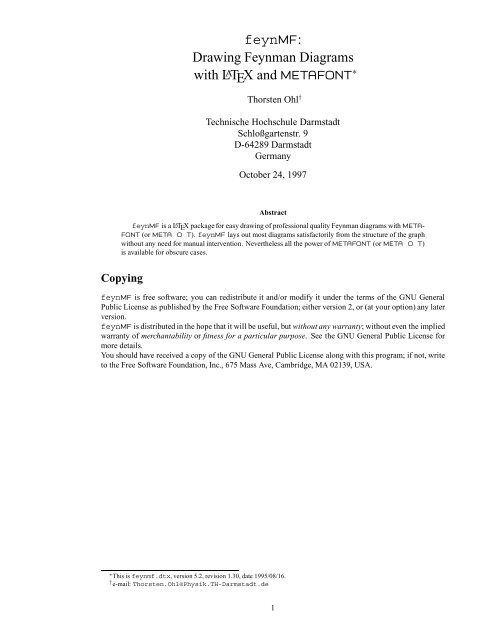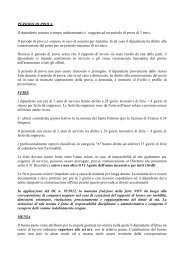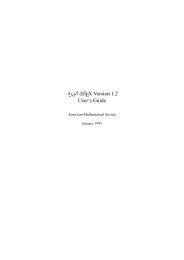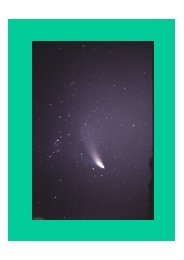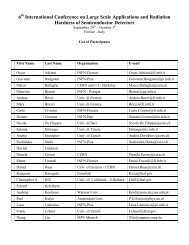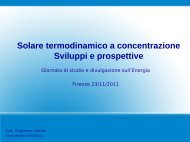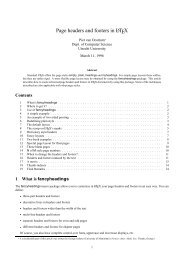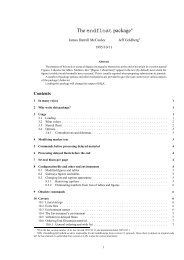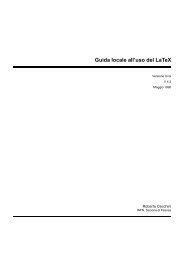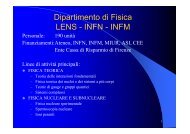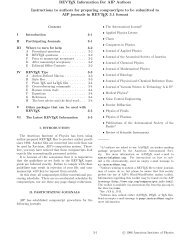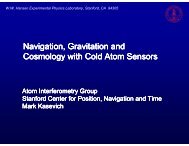Drawing Feynman Diagrams with LATEX and METAFONT - INFN
Drawing Feynman Diagrams with LATEX and METAFONT - INFN
Drawing Feynman Diagrams with LATEX and METAFONT - INFN
Create successful ePaper yourself
Turn your PDF publications into a flip-book with our unique Google optimized e-Paper software.
qFigure 1: Simple scattering diagram.1 Introduction1.1 Purpose <strong>and</strong> scopeIn recent years, TEX 1 [1] <strong>and</strong> L A TEX 2 [2] have revolutionized the way we share information in theoreticalphysics (<strong>and</strong> other areas). Not only does TEX provide typographical capabilities, which transcend thoseof commercial “wordprocessors” substantially, TEX documents are also completely portable. Since implementationsare available on essentially all computers in use in the community, documents can be shared<strong>with</strong>out the usual restrictions of proprietary data formats. This has enabled us to collaborate on papers<strong>with</strong> colleagues on the other side of the globe, to replace the mailing of hard copy preprints by electronictransmission <strong>and</strong> to submit these papers electronically to the publisher.This portability comes <strong>with</strong> a price, though. TEX (<strong>and</strong>L A TEX) do not address the issue of graphical information,apart from the rudimentary (but very useful) capabilities of the L A TEX picture environment <strong>and</strong>similar packages [3]. As an de facto st<strong>and</strong>ard for the inclusion of more complex graphics has emerged theinclusion of PostScript 3 files. The complete document can then be printed on any PostScript device.Still there are areas, where complementary approaches seem worth pursuing. In particular this is the case,if the graphical information is highly formalized, like the case at h<strong>and</strong>. <strong>Feynman</strong> diagrams are specified bytheir topology <strong>and</strong> the type of particles connecting the vertices. Thus a given diagram can be reproducedfrom a very concise specification, if the software is able to choose a reasonable layout (semi-)automatically.<strong>METAFONT</strong> 4 [4] <strong>and</strong> META O T 5 [5] appear to be the perfect tool for such a purpose, since1. <strong>METAFONT</strong> is part of any (reasonable) TEX installation, thus available to all potential users,2. both have very powerful graphics primitivs, which allow high quality output, <strong>and</strong>3. both have builtin linear algebra, which allows us to choose a layout automatically.Still, providing at least the basic interface in L A TEX macros seems appropriate for boosting the acceptanceamong the less technically oriented parts of the audience. Thus feynMF 6 [6, 7] was conceived.feynMF is unique among packages for drawing <strong>Feynman</strong> diagrams in combining the following features:• Simplicity <strong>and</strong> conciseness for common diagrams. E.g. the scattering diagram in figure 1 can bespecified completely in five lines of L A TEX:\begin{fmfgraph*}(40,30) \fmfpen{thick}\fmfleft{i1,i2} \fmfright{o1,o2}\fmf{fermion}{i1,v1,o1} \fmf{fermion}{i2,v2,o2}\fmf{photon,label=$q$}{v1,v2} \fmfdot{v1,v2}\end{fmfgraph*}• Expressiveness for complicated diagrams (see the examples below).• Extensibility (e.g. see section 2.8.1).1 TEX is a trademark of the American Mathematical Society.2 <strong>LATEX</strong> might be a trademark of Addison Wesley Publishing Company.3 PostScript is a trademark of Adobe Systems Inc.4 <strong>METAFONT</strong> is a trademark of Addison Wesley Publishing Company.5 John Hobby’s META O T is a modified version of <strong>METAFONT</strong> which generates (encapsulated) PostScript output. META-O T can be build trivially on top of the web2c version of TEX <strong>and</strong><strong>METAFONT</strong> for UNIX. Ports to other systems should besimple.6 feynMF is not anybody’s trademark.3
LaT E XVertex ModeObjects:verticesarcspolygons\fmfforceImmediate ModeObjects:pairspaths\fmfcmdComm<strong>and</strong>s:\fmf{}{}\fmfv{}{}\fmfleft{}...vlocvpathComm<strong>and</strong>s:\fmfi{}{}\fmfiv{}\fmfiequ{}...<strong>METAFONT</strong>Figure 2: Architecture of feynMF: the two modes of feynMF (immediate mode <strong>and</strong> vertex mode) bothinteract <strong>with</strong> L A TEX<strong>and</strong><strong>METAFONT</strong> (or META O T, respectively), but operate on different data types.1.5 ConclusionIt goes <strong>with</strong>out saying that feynMF is not perfect. There might be cases where using a graphical drawingtool <strong>with</strong> a mouse can give more pleasing results in less time. But in most cases, feynMF will givesatisfactory results <strong>with</strong>out any fine tuning. These will be reproducible <strong>and</strong> independent from the computerit is running on.Early user reponses have been very encouraging. There seems to be a relatively steep learning curve forthose L A TEX users that have to find out how to run <strong>METAFONT</strong> on their systems. But once this purely technicalobstacle has been surmounted, users have been enthusiatic as well about the quality of the generatedgraphs as about the ease of use of feynMF.5
2 UsageIn addition to this manual, there exists also a concise description of feynMF in a journal article [6], as wellas a three part tutorial [7].fmffilefmfgraphfmfgraph*2.1 L A TEX package <strong>and</strong> environmentsInstructing L A TEXtousefeynMF is as simple as 8\usepackage{feynmf}If you have META O T, then you can use it alternatively by placing\usepackage{feynmp}in your L A TEX source. 9feynMF has to switch interactions mode <strong>and</strong> switches to \errorstopmode, because it is impossible inTEX to switch back. If a different default is required (for automated preprint processing, in particular), itcan be specified as a package option:\usepackage[errorstop]{feynmf}\usepackage[scroll]{feynmf}\usepackage[batch]{feynmf}\usepackage[nonstop]{feynmf}All descriptions that should go into one <strong>METAFONT</strong> file are placed inside a fmffile environment whichtakes the name of the <strong>METAFONT</strong> file as an argument:\begin{fmffile}{〈<strong>METAFONT</strong>-file〉}...\end{fmffile}Upto 255 graphs can be placed into one <strong>METAFONT</strong> file. Currently feynMF does not check that the 255graph limit per file is not overrun. 10 Note that the filename for the <strong>METAFONT</strong> file given in the argumentof the fmffile environment must not be identical to the L A TEX source file name, because the <strong>METAFONT</strong>.log would be overwritten <strong>and</strong> L A TEX can no longer access the information in this .log file. It should beobvious that any umber of diagrams can be generated by using more than one fmffile environment <strong>with</strong>different filenames.The fmfgraph environment contains the description of a single <strong>Feynman</strong> diagram which will be placeda the location of the environment. Arguments are the width <strong>and</strong> the height of the diagram, in units of\unitlength:\begin{fmfgraph}(〈width〉,〈height〉)...\end{fmfgraph}This environment does not support labels, use fmfgraph* if your diagrams contains labels.Same as fmfgraph, but enclosed in a picture environment of the same size <strong>and</strong> supporting L A TEXlabels.8 As given, this applies to <strong>LATEX</strong>. But the installation file feynmf209.ins allows to generate special versions feynmf209.sty<strong>and</strong> feynmp209.sty which are compatible <strong>with</strong> the obsolete <strong>LATEX</strong> version 2.09. These files are to be used as documentstyle options\documentstyle[...,feynmf209,...]{...}or\documentstyle[...,feynmp209,...]{...}If you cannot use epsf.sty for including PostScript files, you can either hack feynmp209.sty or upgrade to <strong>LATEX</strong>2e. Pleasekeep in mind that feynMF has been developed for <strong>LATEX</strong>2ε <strong>and</strong> the <strong>LATEX</strong> 2.09 compatibility version will always be a retrofittedhack. I will accept bug reports for the 2.09 version, but I urge everybody to move to <strong>LATEX</strong>2e, which is the one <strong>and</strong> only supported<strong>LATEX</strong> right now.9 feynMF underst<strong>and</strong>s an option pre-1.03, that is of interest for veteran users:\usepackage[pre-1.03]{feynmf}or\usepackage[pre-1.03]{feynmp}The purpose of this option is to enable processing of old input files (pre v1.02) that use \noexp<strong>and</strong> in labels. Since the method forprocessing these files can clash (in rare cases) <strong>with</strong> <strong>LATEX</strong>2ε’s font loading procedure, it has been disabled by default.10 There is also a very primitive, but (unfortunately) popular operating system, which restricts filenames to eight characters <strong>with</strong> athree character extension. On this system, only 99 graphs can be placed into one <strong>METAFONT</strong> file because auxiliary files will not beunambiguous, if more than two digits are used.6
% foo.tex...\usepackage{feynmf}...\begin{fmffile}{fd}\begin{fmfchar*}(100,50)...\end{fmfchar*}...\end{fmffile}...latex foo% fd.mf -- do not editinput feynmfbeginchar(1,100*1pt#,50*1pt#,0);vinit;...vfreeze;vdraw;endchar;...LaT E Xlabelsfd.logmf fdfont bitmapfd.300gflatex fooLaT E Xlabelsfd.t1LaT E Xlabelsfd.t2font metricinformationfd.tfmdevice independentoutput filefoo.dvidvixx fooprinterlprFigure 3: Interdependency of files in a feynMF application. The arrows show which files are updated inthe two L A TEX passes, the <strong>METAFONT</strong> pass <strong>and</strong> the final dvi translation step.\begin{fmfgraph*}(〈width〉,〈height〉)...\end{fmfgraph*}\fmfframeAllows to allocate additional space around a fmfgraph*, since the labels (or the diagram itself) mightovershoot:\fmfframe(〈left〉,〈top〉)(〈right〉,〈bottom〉){〈box〉}puts an invisible frame of the given dimensions (measured in \unitlength) around 〈box〉.2.2 Auxiliary filesfeynMF needs to share information between <strong>METAFONT</strong> <strong>and</strong> L A TEX. For this task several auxiliary filesare needed. The flow of information depicted in figures 3 <strong>and</strong> 4 looks much more complicated than it is.The important feature is that there a two sets of files which can be used to distribute a document:1. Iff the recipient has a working <strong>METAFONT</strong> installation (which shouldn’t be a problem, except forsome impoverished commercial implementations), the document can be typset from the L A TEX sourcealone, by running L A TEX, <strong>METAFONT</strong> <strong>and</strong> L A TEX again (the latter step might have to be repeated toget cross references right).2. Another possibility (which doesn’t require <strong>METAFONT</strong> on the recipient’s side), is to distribute theL A TEX source, the tfm <strong>and</strong> gf files (or pk files respectively) along <strong>with</strong> the label files <strong>with</strong> extensiontn (where n as an integer). Distributing the <strong>METAFONT</strong> log files is a possible alternative for thelatter, but discouraged, because these are prone to be erased accidentally.2.3 Running <strong>METAFONT</strong>Processing your document <strong>with</strong> L A TEX will generate one or more <strong>METAFONT</strong> files, which you will have toprocess <strong>with</strong> <strong>METAFONT</strong>. On UNIX 11 systems, <strong>METAFONT</strong> is invoked as11 UNIX was a trademark of UNIX Systems Laboratory, but is rumored to have been donored to X/Open.7
Running META O T is usually trivial, because not printer specific mode is needed:mp 〈META O T-file〉2.4 The feynmf perl scriptUNIX users will be able to take advantage of the feynmf perl script, that automates the invocation of L A TEX<strong>and</strong> META O T. In particular it tries to guess the correct <strong>METAFONT</strong>-mode <strong>and</strong> magnification. The latteris often different from 1 in slide classes. Here is the man page of feynmf:NAMEfeynmf — Process LaTeX files using FeynMFSYNOPSISfeynmf [-hvqncfT][-t tfm [-t tfm ...]] [-m mode] file [file ...]feynmf [--help] [--version] [--quiet] [--noexec] [--clean] [--force] [--notfm] [--tfmtfm [--tfm tfm ...]] [--mode mode] file [file ...]DESCRIPTIONThe most complicated part of using the FeynMF style appears to be the proper invocation of Metafont.The feynmf script provides a convenient front end <strong>and</strong> will automagically invoke Metafont <strong>with</strong> the propermode <strong>and</strong> magnifincation. It will also avoid cluttering system font directories <strong>and</strong> offers an option to cleanthem.OPTIONS-h, --helpPrintashorthelptext.-v, --versionPrint the version of feynmf.-q, --quietDon’t echo the comm<strong>and</strong>s being executed.-n, --noexecDon’t execute LaTeX or Metafont.-c, --cleanOffer to delete font files that have accidentally been placed in a system directory by the Make-TeXTFM <strong>and</strong> MakeTeXPK scripts (these scripts are run by tex (<strong>and</strong> latex) in the background). Thisoption has only been tested <strong>with</strong> recent versions of UNIX TeX.-f, --forceDon’t ask any questions.-T, --notfmDon’t try to prepare fake .tfm files for the first run.-t, --tfm tfmDon’t try guess the names of the .tfm files to fake for the first run <strong>and</strong> use the given name(s) instead.This option can be useful if our incomplete parsing of the LaTeX input files fails.-m mode, --mode modeSelect the <strong>METAFONT</strong> mode mode. The default is guessed or localfont if the guess fails.fileMain LaTeX input files.file ...Other LaTeX input files that are included by the main file.9
Name Example Parameters Aliasescurly curly_len gluondbl_curlydashescurly_lendash_lendashes_arrow dash_len scalardbl_dashesdbl_dashes_arrowdotsdash_lendash_lendot_lendots_arrow dot_len ghostdbl_dotsdbl_dots_arrowdot_lendot_lenphantomphantom_arrowplainplain_arrowdbl_plaindbl_plain_arrowvanillafermion, electron, quarkdoubledouble_arrow, heavywiggly wiggly_len boson, photondbl_wigglyzigzagdbl_zigzagwiggly_lenzigzag_widthzigzag_lenTable 1: Available line styles\fmfnThe supported options are collected in table 2 13 Note that each of the dot separated components of theoptions can be abbreviated. For example, l.d is equivalent to label.dist. The result of ambiguousmatches is however undefined.Note that because the options are separated by single commata, commata inside arguments to options(label comes to mind) have to be doubled (similar to quotes in Fortran). 14Arcs that return to their origin are allowed (I will refer to them as tadpoles), but some options have slightlydifferent semantics. tension is here a inverse scale factor for the tadpole, whose default size is 2/3 ofthe average distance the neighboring vertices. If left or right are specified, they give the direction (indegrees) of the preferred gap into which the tadpole is placed. By default, the largest gap is chosen for alltapoles at a given vertex, which will therefore overlap. This is neither a bug nor a feature, but a limitation.The macro \fmfn is similar to \fmf,but\fmfn{〈style〉[,〈opt〉[=〈val〉],...]}{〈v〉}{〈n〉}connects the vertices 〈v[1]〉...〈v[n]〉.13 One particulary useful further option would be smooth, allowing for several lines joined smoothly. Early experimentation hasshown however, that the results are not always what one expects <strong>and</strong> that there is a lot of room for abuse.14 Note that, as of version 1.03, it is no longer necessary to escape TEX control sequences in arguments. Old files will continue towork, because noexp<strong>and</strong> is temporarily disabled.11
Name Explanationtension draw a tighter (> 1) or more loose (< 1)arcleft draw on a halfcircle on the leftright draw on a halfcircle on the rightstraight draw on a straight line (default)label TEX text for labeling the arclabel.side force placement of the label on the leftor rightlabel.dist place label at a distance distlabel.pos relative position of the label (not implementedyet!)tagoptional tag for disambiguating arcswidth width of the linerubout scale factor for crossing out lines (doesn’twork properly for doubled lines yet)foreground foreground color (META O T only!)background background color for doubled lines(META O T only!)Table 2: Available line optionsNamelabellabel.anglelabel.distdecoration.shapedecoration.sizedecoration.filleddecoration.angleforegroundbackgroundExplanationTEX text for labeling the vertexforce placement of the label at the givenangle from the vertexplace label at a distance distshape of decorationsize of decorationfill, shade or hatch decorationrotate decorationforeground color (META O T only!)background color (META O T only!)Table 3: Available vertex options\fmfcyclen\fmfrcyclen\fmfpen\fmfvThe macro \fmfcyclen{〈style〉}{〈v〉}{〈n〉} cyclically connects the vertices 〈v[1]〉...〈v[n]〉. \fmfrcyclenoperates in reverse order.Pick up a pen of the specified size. \fmfpen{〈weight〉} is used for changing the weight (i.e. thickness)of the lines. Predefined sizes are thin <strong>and</strong> thick.Declare vertices <strong>with</strong> options:\fmfv{〈opt〉[=〈val〉][,〈opt〉[=〈val〉],...]}{〈v1〉[,...]}\fmfblobThis is used for adding labels to a vertex <strong>and</strong> for specifying other decoration. Supported options are collectedin table 3. Here the same abbreviation mechanism as above is in effect. The available shapesare listed in various filling styles in table 4 15 . The tilings gray10, gray25, gray75 <strong>and</strong> gray90are available in addition to gray50. Customized tilings can be created <strong>with</strong> the <strong>METAFONT</strong> functiontile_from_string. It should be noted however, that tilings are gobbling up memory at high speed<strong>and</strong> should be used <strong>with</strong> discretion. The halftones 16 can be accessed by giving any number from 2 to 99,which will denote the percentage of saturation (30% <strong>and</strong> 70% here) 17 . Again, commata inside argumentsto options have to be doubled.Draw a blob of the specified diameter at the vertices. Incidentally,15 If the variable feymfwizard is true (e.g. after calling the \fmfwizard macro), it is also possible to specify any META-FONT expression that evaluates to a path. Naturally, this has to used <strong>with</strong> great care, because strange errors can be triggered bytypos!16 META O T will give true halftones (if your printer supports them), while <strong>METAFONT</strong> tries to mimic them. The ditheringalgorithm of the latter will be improved in the future.17 The old numeric arguments in the range −1 ...1continue to work, but are considered obsolete.12
filled= full empty shaded hatched gray50 30 70circlesquaretrianglediamondpentagonhexagontriagramtetragrampentagramhexagramtriacross cross pentacross hexacrossTable 4: Available vertex shapes <strong>and</strong> fill styles.\fmfblob{〈diameter〉}{〈v1〉[,...]}is equivalent to\fmfv{decor.shape=circle,decor.filled=shaded,decor.size=〈diameter〉}{〈v1〉[,...]}\fmfdotDraw a dot at the vertices given as arguments.\fmfdot{〈v1〉[,...]}is equivalent to\fmfv{decor.shape=circle,decor.filled=full,decor.size=2thick}{〈v1〉[,...]}\fmfvnThe macro \fmfvn is similar to \fmfv,but\fmfvn{〈opt〉[=〈val〉][,〈opt〉[=〈val〉],...]}{〈v〉}{〈n〉}\fmfdotn\fmfblobnplaces the vertices 〈v[1]〉...〈v[n]〉.The macros \fmfdotn <strong>and</strong> \fmfblobn are similar to the \fmfdot <strong>and</strong> \fmfblob,but\fmfdotn{〈v〉}{〈n〉}places the vertices 〈v[1]〉...〈v[n]〉. Analogously for \fmfblobn.2.5.3 Polygons\fmfpolyComplex vertices <strong>with</strong> arcs attached at the corners can be contructed <strong>with</strong> polygons, which share somecharacteristics <strong>with</strong> arcs <strong>and</strong> vertices.The macro\fmfpoly{〈style〉[,〈opt〉[=〈val〉],...]}{〈v1〉,〈v2〉[,...]}13
NameExplanationfilled fill, shade or hatch interiorphantom don’t draw anythingempty draw outlineshade shade interiorhatched hatch interiorfullfill interiorpull pull edges in (< 0) or out (> 0)tension tension of the edgessmooth draw smoth cornerslabel TEX text for labeling the polygonlabel.angle force placement of the label at the givenangle from the vertexlabel.dist place label at a distance distforeground foreground color (META O T only!)background background color (META O T only!)Table 5: Available polygon optionspull= 0.75 1.0 ? 1.5defaultsmoothdefaultsmoothdefaultsmoothTable 6: Some of the available polygon shapes. Note that pull=1.0 is identical to pull=? for straightlines, but very different for smooth lines.\fmfpolyn\fmfrpolynplaces the vertices 〈v1〉, 〈v2〉, . . . on the corners of a regular polygon. The orientation of the polygon isfixed to be mathematically positive (i.e. counter clockwise). Note that this can have strange results if theorientation is opposite to the orientation of the vertices the corners are connected to. The available optionsare collected in table 5. The effects of some options are depicted in table 6.Note that is is technically impossible to fix the size of a polygon. The size can be controlled by specifyinga tension for the edges, which acts like the tension of normal arcs.The macro \fmfpolyn{〈style〉}{〈v〉}{〈n〉} is similar to \fmfpoly but connects the vertices 〈v[1]〉...〈v[n]〉.\fmfrpolyn operates in reverse order.14
2.5.4 ColorIf META O T is used for rendering the diagrams, vertices <strong>and</strong> arcs can be colored. The correspondingoptions give a warning message under <strong>METAFONT</strong> <strong>and</strong> are otherwise ignored.Two colors are available for vertices <strong>and</strong> arcs: foreground <strong>and</strong> background. Both can either be specifiedas a linear combination of the predefined colors white, black, red, green <strong>and</strong> blue or as RBGtriples (〈red〉,〈green〉,〈blue〉). Note that as always commata have to be doubled in option arguments.Therefore both foreground=(1,,0,,1) <strong>and</strong> foreground=red+blue are valid options setting theforeground color to magenta. For arcs, the background color is used only for the interior of doubled lines.While the color feature is rarely used in papers or books, it can be very useful for jazzing up your transparencies.See page 20 for a not very serious example.2.5.5 ExamplesAfter the main features of the vertex mode have been introduced, it is time for a couple of illustrativeexamples that are taken from The Real World.As a first example, consider drawing a straightforward box diagram, familiar from K- ¯K, D- ¯D, <strong>and</strong>B-¯Bmixing. The comm<strong>and</strong>s for the labels are not shown here, they are discussed in section 2.5.6Let us start the diagram <strong>and</strong> pick up a thick pen:\begin{fmfgraph}(40,25)\fmfpen{thick}The incoming <strong>and</strong> outcoming vertices are placed on the left <strong>and</strong> right h<strong>and</strong> side, respectively:\fmfleft{i1,i2}\fmfright{o1,o2}dbNow we tell feynMF how the arcs are connected.W +t, c, u¯t, ¯c, ūW −\fmf{fermion}{i1,v1,v3,o1}\fmf{fermion}{o2,v4,v2,i2}\fmf{photon}{v1,v2}\fmf{photon}{v3,v4}¯b¯dFinally we tell feynMF to draw dots at the vertices <strong>and</strong> we’re done.\fmfdotn{v}{4}\end{fmfgraph}With a little effort the layout of this diagram can actually be improved by enlarging the inner box,seepage21below.Here is the resonant s-channel contribution to e + e − → 4f. (From now on, we do no longer displaythe\begin{fmfgraph}(40,25)\fmfpen{thick}...\end{fmfgraph}environment surrounding all pictures.)\fmfleftn{i}{2}\fmfrightn{o}{4}\fmf{fermion}{i1,v1,i2}\fmf{photon}{v1,v2}\fmfblob{.15w}{v2}15
e − µ +ν µe + ¯csν µµ +s\fmf{photon}{v2,v3}\fmf{fermion}{o1,v3,o2}\fmf{photon}{v2,v4}\fmf{fermion}{o4,v4,o3}And the resonant t-channel contribution:\fmfleftn{i}{2}\fmfrightn{o}{4}\fmf{fermion}{i1,v1,v2,i2}\fmf{photon}{v1,v3}\fmf{fermion}{o1,v3,o2}\fmf{photon}{v2,v4}\fmf{fermion}{o4,v4,o3}e −Two point loop diagrams pose another set of problems. We must have a way of specifying that one ormore of the lines connecting the two vertices are not connected by a straight line. The options left,right <strong>and</strong> straight offer the possibility to connect two vertices by a semicircle detour, eitheron the left or on the right. Since by default all lines contribute to the tension between two vertices,the tension option allows us to reduce this tension. The next examples shows both options inaction. The lower fermion line is given an tension of 1/3 to make is symmetrical <strong>with</strong> the upper line<strong>with</strong> consists of three parts. The loop photon is using a detour on the right <strong>and</strong> does not contributeany tension.p ′ pp − kk\fmfleft{i1,i2}\fmfright{o1}\fmf{fermion,tension=1/3}{i1,v1}\fmf{plain}{v1,v2}\fmf{fermion}{v2,v3}\fmf{photon,right,tension=0}{v2,v3}\fmf{plain}{v3,i2}\fmf{photon}{v1,o1}The optional argument to left <strong>and</strong> right can be used to deform the corresponding contour as inthe following example. The default value of left <strong>and</strong> right is 1.\fmfleft{i} \fmfright{o}\fmf{plain}{i,v1} \fmf{plain}{v2,o}\fmf{dots,left=.5,tension=0.3}{v1,v2,v1}\fmffreeze\fmf{plain,left}{v1,v2,v1}\fmf{dashes,left=1.5}{v1,v2,v1}Polygons are particulary useful for depicting non-perturbative contributions:ΓK\fmfpen{thick}\fmfleftn{l}{2}\fmfrightn{r}{2}\fmfrpolyn{shaded,label=$\Gamma$}{G}{4}\fmfpolyn{empty,label=$K$}{K}{4}\fmf{fermion}{l1,G1}\fmf{fermion}{l2,G2}\fmf{fermion}{K1,r1}\fmf{fermion}{K2,r2}\fmf{fermion,left=.5,tension=.5}{G3,K3}\fmf{fermion,right=.5,tension=.5}{G4,K4}To conclude this first picture show, here’s a self energy in scalar φ 4 -theory showing the simplicityof the tadpole feature:\fmfpen{thick}\fmfleft{i}\fmfright{o}\fmf{plain}{i,v,v,o}\fmfdot{v}16
Scalar φ 6 -theory needs a little manual intervention to force the second on the opposite side:\fmfpen{thick}\fmfleft{i}\fmfright{o}\fmf{plain}{i,v,v,o}\fmf{plain,left=90}{v,v}\fmfdot{v}2.5.6 Labels\fmflabelLet us now come back to the examples on page 15 <strong>and</strong> discuss how to add the labels.The macro\fmflabel{〈label〉}{〈v〉}is equivalent to\fmfv{label=〈label〉}{〈v〉}<strong>and</strong> adds the label 〈label〉 to the vertex 〈v〉. In the current implementation, there can be only a single labelfor each vertex. Thus earlier calls to \fmflabel for the same vertex will be overwritten. 〈label〉 willbe placed <strong>with</strong> the \put comm<strong>and</strong> of the L A TEX picture environment. 18 Note that the fmfgraph*environment must be used to use labels, they will silently disappear in fmfgraph.\fmflabel gives the user no control on the placement of the the label (use the \fmfv macro for a morefine-grained control). The label is placed using the following algorithm:1. The reference point of the box containing 〈label〉 is placed at the distance 3thick on the continuationof the straight line connecting the center of the picture <strong>with</strong> the vertex 〈v〉.2. The reference point of the box is chosen such that the contents of the box is on the outside of thevertex (<strong>with</strong> respect to the center of the diagram). It is chosen from the four corners <strong>and</strong> the fourmidpoints of the sides.Therefore the four external particles in the B- ¯B mixing diagram on page 15 are labelled simply by:\fmflabel{$\bar{b}$}{i1}\fmflabel{$d$}{i2}\fmflabel{$\bar{d}$}{o1}\fmflabel{$b$}{o2}Here is a more systematical demonstration of the default placement of labels:v 4v 3v 2v 1\fmfsurroundn{v}{8}\fmfdotn{v}{8}\fmflabel{$v_1$}{v1}\fmflabel{$v_2$}{v2}\fmflabel{$v_3$}{v3}\fmflabel{$v_4$}{v4}\fmflabel{$v_5$}{v5}\fmflabel{$v_6$}{v6}\fmflabel{$v_7$}{v7}\fmflabel{$v_8$}{v8}v 5v 6v 7v 8And here is a demonstration of the explicit placement of labels 19 :\fmfiv{d.sh=circle,d.f=1,d.si=2thin}{c}\fmfiv{l=-120,l.a=-120,l.d=.2w}{c}18 Note again that, as of version 1.03, it is no longer necessary to escape TEX control sequences in arguments. Old files will continueto work, because noexp<strong>and</strong> is temporarily disabled.19 Don’t be confused by the \fmfiv comm<strong>and</strong>. It is described below (see section 2.7.2) <strong>and</strong> takes the same arguments as the\fmfv comm<strong>and</strong>. We use it here for convenience to place multiple vertices at the same point, i.e. the center.17
120 60180 0-120 -60\fmfiv{l=-60,l.a=-60,l.d=.2w}{c}\fmfiv{l=0,l.a=0,l.d=.2w}{c}\fmfiv{l=60,l.a=60,l.d=.2w}{c}\fmfiv{l=120,l.a=120,l.d=.2w}{c}\fmfiv{l=180,l.a=180,l.d=.2w}{c}There is no equivalent to \fmflabel for arcs. Here options to the \fmf comm<strong>and</strong> have to be used. Thedefault placement rules put the label on the outside at the midpoint of a curved arc. If the arc is straight,one should use the label.side option to push the label either to the left or to the right. Thislabel.dist option is treated analogously to same option for vertices.Therefore the four internal particles in the B- ¯B mixing diagram on page 15 are labelled simply by addingoptions to the \fmf comm<strong>and</strong>s:\fmf{fermion,label=$\bar{t},,\bar{c},,\bar{u}$,label.side=right}{v1,v3}\fmf{fermion,label=$t,,c,,u$,label.side=right}{v4,v2}\fmf{photon,label=$Wˆ+$,label.side=left}{v1,v2}\fmf{photon,label=$Wˆ-$,label.side=right}{v3,v4}2.5.7 Manipulating the layout\fmffreeze\fmfforce\fmfshift\fmffixed\fmffixedx\fmffixedyThe automatic layout algorithms of feynMF are rather simple, therefore it is sometimes necessary to allowfor manual intervention from time to time.Calculate the positions of the vertices based on the arcs which are defined up to this point. Usually thiscalculation is performed automatically at the end of the fmfgraph environment. Calling it explicitelyis useful for later adding arcs that should not enter the calculation . The layout is chosen to minimize theoverall length of all arcs. The length of each arc is weighted <strong>with</strong> the tension option, whose default valueis 1. See section 2.5.8 for more information on \fmffreeze.\fmfforce{〈pos〉}{〈v1〉[,...]} forces the position 〈pos〉 of the vertices 〈v1〉..., bypassing <strong>and</strong> overwritingthe automatic layout. In all arguments that are <strong>METAFONT</strong> pairs (i.e. points), you can use thevariable w <strong>and</strong> h, which are predefined to the width <strong>and</strong> the height of the whole diagram respectively.E.g. the center is specified as (.5w,.5h) <strong>and</strong> the lower right corner as (w,0). The center <strong>and</strong> the fourcorners of the current subgraph (see the fmfsubgraph environment on page 22) are available as c, nw,ne, sw <strong>and</strong> se (for north-west etc).\fmfshift{〈dist〉}{〈v1〉[,...]} shifts the position of the vertices 〈v1〉... by 〈dist〉 from the automaticlayout. This comm<strong>and</strong> is only useful after a \fmffreeze of the corresponding vertex.\fmffixed{〈dist〉}{〈v1〉[,...]} fixes the distance between subsequent vertices in the list 〈v1〉... to〈dist〉. This comm<strong>and</strong> should be used <strong>with</strong> care, because it is possible to overconstrain the layout of thegraph <strong>and</strong> the error messages will be obscure for a novice user.\fmffixedx{〈dx〉}{〈v1〉[,...]} is identical to \fmffixed{(〈dx〉,whatever)}{〈v1〉[,...]} <strong>and</strong>\fmffixedy{〈dy〉}{〈v1〉[,...]}is identical to \fmffixed{(whatever,〈dy〉)}{〈v1〉[,...]}.Thesecomm<strong>and</strong>s can be used to fix relative positions in one coordinate, while allowing movement in the othercoordinate.2.5.8 SkeletonsThe single most powerful concept for adjusting feynMF’s layout decisions is the use of skeletons. Byissuing a \fmffreeze after specifying a subgraph (skeleton), we can fix the location of the skeletonas if the other arcs were not there. We can then successively add more subgraphs whose layout will bechosen <strong>with</strong> the skeleton remaining fixed. Similar effects can be achieved by giving some arcs a vanishingtension.Consider the following example: suppose we want to draw a ladder diagram contributing to thequark form factor. Simply linking in the gluons does not produce a satisfactory result:\fmfleft{i1} \fmfright{o1,o2}\fmf{photon}{i1,v4}\fmf{quark}{o1,v1,v2,v3,v4,v5,v6,v7,o2}\fmf{gluon}{v1,v7}\fmf{gluon}{v2,v6}\fmf{gluon}{v3,v5}18
What went wrong? Obviously the gluons are bonding the quark lines too strongly. The fix is simple:just create a skeleton excluding the gluons\fmfleft{i1} \fmfright{o1,o2}\fmf{photon}{i1,v4}\fmf{quark}{o1,v1,v2,v3,v4,v5,v6,v7,o2}<strong>and</strong> add the gluons later:\fmfleft{i1} \fmfright{o1,o2}\fmf{photon}{i1,v4}\fmf{quark}{o1,v1,v2,v3,v4,v5,v6,v7,o2}\fmffreeze\fmf{gluon}{v1,v7}\fmf{gluon}{v2,v6}\fmf{gluon}{v3,v5}Alternatively, we can use a vanishing tension, which will effectively exclude the gluons from thelayout decisions:\fmfleft{i1} \fmfright{o1,o2}\fmf{photon}{i1,v4}\fmf{quark}{o1,v1,v2,v3,v4,v5,v6,v7,o2}\fmf{gluon,tension=0}{v1,v7}\fmf{gluon,tension=0}{v2,v6}\fmf{gluon,tension=0}{v3,v5}Which method is more intuitve is largely a matter of taste <strong>and</strong> at the discretion of the user.The “crossed” version of this diagram is best drawn using the rubout option:\fmfleft{i1} \fmfright{o1,o2}\fmf{photon}{i1,v3}\fmf{quark}{o1,v1,v2,v3,v4,v5,o2}\fmffreeze\fmf{gluon}{v1,v4}\fmf{gluon,rubout}{v2,v5}If rubout is selected, it defaults to 2, but it can be changed to any (reasonable) value > 1. Thecurrent implementation should work for almost all user-defined line styles. However, it does notwork correctly for the predefined double line styles yet.Another instructive example is the following: imagine you want to draw a typical non-resonantcontribution to e + e − → 4f. The obvious solution doesn’t look right:\fmfleft{i1,i2}\fmfright{o1,o2,o3,o4}\fmf{fermion}{i1,v1,i2}\fmf{boson}{v1,v2}\fmf{fermion}{o1,v2,v3,o4}\fmf{boson}{v3,v4}\fmf{fermion}{o3,v4,o2}Again, we should start <strong>with</strong> a skeleton\fmfleft{i1,i2}\fmfright{o1,o2,o3,o4}\fmf{fermion}{i1,v1,i2}\fmf{boson}{v1,v2}\fmf{fermion}{o1,v2,v3,o4}19
<strong>and</strong> add the second W later:\fmfleft{i1,i2}\fmfright{o1,o2,o3,o4}\fmf{fermion}{i1,v1,i2}\fmf{boson}{v1,v2}\fmf{fermion}{o1,v2,v3,o4}\fmffreeze\fmf{boson}{v3,v4}\fmf{fermion}{o3,v4,o2}Here’s another example that uses stretchable arcs. <strong>Diagrams</strong> of this kind are known as rainbowdiagrams. If you’re using META O T <strong>and</strong> are watching this on a color device, you’ll see why.\fmfpen{thick}\fmfleft{i1,d1}\fmfright{o1,d2}\fmfn{plain}{i}{4}\fmf{plain}{i4,v,o4}\fmfn{plain}{o}{4}\fmffreeze\fmf{gluon,left,fore=red}{i1,o1}\fmf{gluon,left,fore=green}{i2,o2}\fmf{gluon,left,fore=blue}{i3,o3}\fmfdotn{i}{3}\fmfdotn{o}{3}\fmfv{d.sh=circle,d.f=empty,d.si=.2w,b=(1,,0,,1),l=$\Sigma$}{v}ΣExperience has shown that the method advocated in this section is more effective than fuzzing around <strong>with</strong>fractional tension parameters. Using \fmfshift or \fmfforce should be a last resort only.2.5.9 Pulling stringsIf you add to any arc one or more phantom arcs they will cause a tighter bonding between the verticesinvolved\fmf{fermion}{v1,v2}\fmf{phantom}{v1,v2}which is equivalent to\fmf{fermion,tension=2}{v1,v2}The phantom arc has to be added before any \fmffreeze involving these vertices, of course.Here is an example from deep inelastic scattering 20 :\fmfleft{ip,il}\fmfright{oq1,oq2,d1,oq3,d2,d3,ol}\fmf{fermion}{ip,vp,vq,oq3}\fmf{fermion}{vp,oq1}\fmf{fermion}{vp,oq2}\fmf{photon}{vl,vq}\fmf{fermion}{il,vl,ol}\fmfblob{.15w}{vp}\fmfdot{vq,vl}\fmffreeze\fmfi{plain}{vpath (__ip,__vp) shifted (thick*(0,2))}\fmfi{plain}{vpath (__ip,__vp) shifted (thick*(1,-2))}20
2.6 Miscellaneous comm<strong>and</strong>s2.6.1 Graphs in graphsfmfsubgraphThe fmfsubgraph environment contains a subgraph, for which the galleries will be placed inside therectangle of width 〈width〉 <strong>and</strong> height 〈height〉, <strong>with</strong> lower left corner at (〈x〉, 〈y〉):\begin{fmfsubgraph}(〈x〉,〈y〉)(〈width〉,〈height〉)〈body〉\end{fmfsubgraph}The center <strong>and</strong> four corners are available as c, nw, ne, sw <strong>and</strong> se (for north-west etc). Because of therestrictions on the overall size of the diagram in <strong>METAFONT</strong>, this environment will, mainly be useful forpreparing transparencies <strong>with</strong> META O T.Here is a not very serious application of this feature:\def\subgraphsample#1{%\fmfleftn{#1i}{2}%\fmfrightn{#1o}{2}%\fmf{plain}{#1i1,#1v1}%\fmf{plain}{#1o1,#1v2}%\fmf{plain}{#1o2,#1v3}%\fmf{plain}{#1i2,#1v4}%\fmfcyclen{plain,tension=0.3}{#1v}{4}}\begin{fmfgraph}(40,30)\subgraphsample{a}\begin{fmfsubgraph}(.3w,.3h)(.4w,.4h)\subgraphsample{b}\end{fmfsubgraph}\begin{fmfsubgraph}(.45w,.45h)(.1w,.1h)\subgraphsample{c}\end{fmfsubgraph}\end{fmfgraph}More serious applications will use this feature to group together related diagrams <strong>and</strong> use other<strong>METAFONT</strong> drawing comm<strong>and</strong>s for graphical elements that are not available in the L A TEX pictureenvironment.2.6.2 Reusing diagrams\fmfkeep\fmfreuseAfter saving a pointer <strong>with</strong> \fmfkeep{〈name〉} inside a fmfgraph or fmfgraph* environment, thediagram can be reused later by \fmfreuse{〈name〉}. This works across fmffile environments.Here’s an example that uses centered \parboxes to place diagrams into equations. The celebrated cancelationof quadratic divergencies in scalar selfenergies in supersymmetric field theories can be writtenas:\begin{eqnarray}\parbox{20mm}{\begin{fmfgraph}(20,15)\fmfkeep{boson}\fmfleft{i} \fmfright{o} \fmf{dashes}{i,v,v,o}\end{fmfgraph}} & \propto & \Lambdaˆ2 \\\parbox{20mm}{\begin{fmfgraph}(20,15)\fmfkeep{fermion}\fmfleft{i} \fmfright{o} \fmf{dashes}{i,v1} \fmf{dashes}{v2,o}\fmf{fermion,left,tension=.3}{v1,v2,v1}\end{fmfgraph}} & \propto & \Lambdaˆ2 \\\parbox{20mm}{\fmfreuse{boson}} \quad + \quad\parbox{20mm}{\fmfreuse{fermion}} & \propto & \ln\Lambdaˆ2\end{eqnarray}The result is:∝ Λ 2 (1)22
Parameter Default Semanticsthin 1pt thin arcsthick 1.5thin thicker arcsarrow_len 4mm length of arrow headarrow_ang 15 opening angle of arrow headcurly_len 3mm length of one curldash_len 3mm length of one dashdot_len 2mm distance of two dotswiggly_len 4mm length of one wigglewiggly_slope 60 inclination of wiggleszigzag_len 2mm length of a zig-zag periodzigzag_width 2thick width of zig-zag linesdecor_size 5mm default size of vertex decorsdot_size 4thick diameter of dotsTable 7: Available style parameters.∝ Λ 2 (2)+ ∝ ln Λ 2 (3)2.6.3 GroupingfmfgroupMake the enclosed \fmfset assignments local to this environment.2.6.4 Changing parameters\fmfsetThis comm<strong>and</strong> can be used to change the parameters in table 7 as follows:\fmfset{〈parameter〉}{〈value〉}Note that these parameters are not stored in the graph data structure for the individual vertices <strong>and</strong> arcs.Instead the current values at the time of \fmfdraw are used.2.6.5 ShrinkingfmfshrinkShrink the linewidths <strong>and</strong> similar parameters in the enclosed section.2.6.6 Debugging\fmftrace\fmfnotrace\fmfdisplay\fmfstopdisplayfmfforEnable <strong>and</strong> disable tracing of the layout decisions. This is not necessarily printed in an intuitive format,but can be helpful for debugging.Enable online displays. \fmfstopdisplay will halt <strong>METAFONT</strong> everytime a graph is complete.2.6.7 Multiple vertices <strong>and</strong> arcsThe environment\begin{fmffor}{〈var〉}{〈from〉}{〈step〉}{〈to〉}〈body〉\end{fmffor}executes 〈body〉 multiple times, setting 〈var〉 to 〈from〉, 〈from〉 + 〈step〉,...,〈to〉. An application of thisabove feynMF feature is shown in figure 7, which is generated by calling the TEX macro\def\EulerHeisenberg#1{%23
Figure 7: Higher order terms in the Euler-Heisenberg lagrangian.Figure 8: Particle-particle ring diagrams\begin{fmfgraph}(40,25)\fmfpen{thick}\fmfsurroundn{e}{#1}\begin{fmffor}{n}{1}{1}{#1}\fmf{photon}{e[n],i[n]}\end{fmffor}\fmfcyclen{fermion,tension=#1/8}{i}{#1}\end{fmfgraph}}<strong>with</strong> the arguments 4, 6, 8, <strong>and</strong> 10, respectively.Similarly, we can draw the diagrams from many particle physics in figures 8 <strong>and</strong> 9:\def\PPRing#1{%\begin{fmfgraph}(20,20)\fmfsurroundn{v}{#1}\fmfdotn{v}{#1}\fmfcyclen{fermion,right=0.25}{v}{#1}\fmfcyclen{fermion,left=0.25}{v}{#1}\end{fmfgraph}}\def\PHRing#1{%\begin{fmfgraph}(20,20)\fmfsurroundn{v}{#1}\fmfdotn{v}{#1}\fmfcyclen{fermion,right=0.25}{v}{#1}\fmfrcyclen{fermion,right=0.25}{v}{#1}\end{fmfgraph}}2.7 Immediate modeIn addition to the automatic layout of vertices, feynMF features an immediate mode, in which feynMF’sdrawing comm<strong>and</strong>s operate directly on <strong>METAFONT</strong>’s pairs <strong>and</strong>paths. You might want to consultThe <strong>METAFONT</strong> Book [4] or the META O T manual [5] for further information on the available pathexpressions.24
Figure 9: Particle-hole ring diagrams2.7.1 Arcs\fmfiImmediate mode’s brother of \fmf.\fmfi{〈style〉[,〈opt〉[=〈val〉],...]}{〈p〉}draws a line of style 〈style〉 on path 〈p〉. Usethevpath function in 〈p〉 (after \fmffreeze!) to access the<strong>METAFONT</strong> path connecting two vertices: vpath[〈tag〉](〈from〉,〈to〉). The optional numeric 〈tag〉 canbe used together <strong>with</strong> a matching tag option to \fmf to disambiguate arcs that connect the same vertices.You have to prepend each name of a vertex in vpath’s arguments <strong>with</strong> two underscores (e.g. v1 becomes__v1). This is necessary for avoiding nameclashes <strong>with</strong> some reserved words in <strong>METAFONT</strong> (sparks inDEK’s terminology).2.7.2 Vertices\fmfivImmediate mode’s brother of \fmfv.\fmfiv{〈shape〉[=〈val〉][,〈opt〉[=〈val〉],...]}{〈v〉}draws a vertex at position 〈v〉. Note that here 〈v〉 is a <strong>METAFONT</strong> pair <strong>and</strong> not a feynMF vertexname. The former’s equivalent of the latter can be accessed (after \fmffreeze!) <strong>with</strong> the vloc function:vloc(〈vertex〉). Again, you have to prepend the name of the vertex in vloc’s argument <strong>with</strong> twounderscores (e.g. v1 becomes __v1).2.7.3 Declarations\fmfipath\fmfipairThe argument(s) are declared <strong>METAFONT</strong> paths.The argument(s) are declared <strong>METAFONT</strong> pairs (coordinates).2.7.4 Assignments\fmfiequ\fmfisetEstablish equality for the two arguments, i.e. \fmfiequ{lval}{rval} translates to lval=rval.Assign the second argument to the first, i.e. \fmfiset{lval}{rval} translates to lval:=rval.Specifying equality of two variables is a very different operation from assignment in <strong>METAFONT</strong>. SeeThe<strong>METAFONT</strong> Book [4] for details on <strong>METAFONT</strong>’s builtin equation solver.2.7.5 ExamplesHere is a non-trivial example of immediate mode, which shows some useful tricks. The non-trivial aspectof the diagram in question is that it has lines broken in two, denoting particles coupling to a condensate.We start the diagram <strong>with</strong> a skeleton (the phantom lines are shown as thin lines for clarity):\fmfleft{i}\fmfright{o}\fmf{dots}{i,v1}\fmf{dots}{v2,o}\fmf{phantom,left,tension=0.2,tag=1}{v1,v2}\fmf{phantom,left,tension=0.2,tag=2}{v2,v1}\fmfdot{v1,v2}\fmfposition25
Add the fermions to the skeleton\fmfipath{p[]}\fmfiset{p1}{vpath1(__v1,__v2)}\fmfiset{p2}{vpath2(__v2,__v1)}\fmfi{fermion}{subpath (0,length(p1)/3) of p1}\fmfi{fermion}{subpath (2length(p1)/3,length(p1)) of p1}\fmfi{fermion}{subpath (0,length(p2)/3) of p2}\fmfi{fermion}{subpath (2length(p2)/3,length(p2)) of p2}Add condensates <strong>and</strong> a gluon\def\cond#1#2{%\fmfiv{d.sh=cross,d.ang=#1,d.siz=5thick}{#2}}\cond{30}{point length(p1)/3 of p1}\cond{-30}{point 2length(p1)/3 of p1}\cond{30}{point length(p2)/3 of p2}\cond{-30}{point 2length(p2)/3 of p2}\fmfi{gluon}{point length(p1)/10 of p1-- point 11length(p1)/12 of p1}\def\vert#1{%\fmfiv{d.sh=circle,d.f=1,d.siz=2thick}{#1}}\vert{point length(p1)/12 of p1}\vert{point 11length(p1)/12 of p1}Here’s an interesting abuse of feynMF (see the next section for \fmfcmd):x\begin{fmfgraph*}(40,40)\fmfipair{o,xm,xp,ym,yp}\fmfiequ{o}{(.5w,.1h)}\fmfiequ{xm}{(0,.1h)}\fmfiequ{xp}{(w,.1h)}\fmfiequ{ym}{(.5w,0)}\fmfiequ{yp}{(.5w,h)}\fmfiv{l=$x$,l.a=-135,l.d=2mm}{xp}\fmfiv{l=$y=xˆ2$,l.a=-135,l.d=2mm}{yp}\fmfpen{thin}\fmfcmd{draw xm--xp; draw ym--yp;}\fmfpen{thick}\fmfiequ{xs}{xpart(xp-o)}\fmfiequ{ys}{ypart(yp-o)}\fmfcmd{draw (o + (-xs,ys)) for n = -9 upto 10:--(o + (xs*(n/10),ys*((n/10)**2)))endfor;}\end{fmfgraph*}y = x 2 Finally, for the curious, here is how to draw the circular gluons in figure 10:\fmfi{gluon}{fullcircle scaled .5w shifted (.5w,.5h)}\fmfi{gluon}{reverse fullcircle scaled .5w shifted (.5w,.5h)}\fmfcmd2.8 Raw <strong>METAFONT</strong>Some more advanced features of feynMF are more conveniently accessed through raw <strong>METAFONT</strong> comm<strong>and</strong>s.This can either be achieved by preparing a <strong>METAFONT</strong> input file or by using \fmfcmd extensively.The latter apprach is usally more convenient.The \fmfcmd macro writes its argument into the <strong>METAFONT</strong> input file generated by feynMF. Whilesome experience in using <strong>METAFONT</strong> doesn’t hurt here, this approach can simplify the production ofcomplex diagrams considerably. Note that no semicolon is appended, the user has to provide it explicitely.26
Figure 10: Circular gluons.2.8.1 Extending feynMFA prominent example for using raw <strong>METAFONT</strong> is provided by the option to add new styles for arcs. Thereis of course always one more style that must be added to the default list. But increasing this list <strong>with</strong>outbounds will eventually slow down feynMF <strong>and</strong> increase its memory requirements. It is therefore betterto allow users to define their own styles. This is done <strong>with</strong> the <strong>METAFONT</strong> macro style_def, whichdefines a macro that will be called to do the drawing <strong>and</strong> registers this macro <strong>with</strong> feynMF so that it canbe used in the first argument to \fmf.The macro takes one argument of type path <strong>and</strong> is responsible for drawing the arc on this path. IfMETA O T’s color functionality is to be used, the color aware functions cdraw, cfill, cfilldraw,ccutdraw <strong>and</strong> cdrawdot should be used instead of draw,etc.After the following style_def, a new style crossed will be available:\fmfcmd{%vardef cross_bar (expr p, len, ang) =((-len/2,0)--(len/2,0))rotated (ang + angle direction length(p)/2 of p)shifted point length(p)/2 of penddef;style_def crossed expr p =cdraw p;ccutdraw cross_bar (p, 5mm, 45);ccutdraw cross_bar (p, 5mm, -45)enddef;}it can be used just like any other style:\fmfleft{i}\fmfright{o}\fmf{plain}{i,v,o}\fmf{crossed}{v,v}\fmfdot{v}And here is an (esthetically questionable!) attempt at wiggly lines <strong>with</strong> arrows:\fmfcmd{%style_def wiggly_arrow expr p =cdraw (wiggly p);shrink (2);cfill (arrow p);endshrink;enddef;}Note how the shrink macro (which is the <strong>METAFONT</strong> equivalent of the fmfshrink environment)is used to temporarily double the dimensions of the arrowhead which is constructed by thearrow macro.27
In particular theorists beyond the st<strong>and</strong>ard model are likely to need alotof different line styles. Theaficionados of majorana neutrinos might find the following two useful:\fmfcmd{%style_def majorana expr p =cdraw p;cfill (harrow (reverse p, .5));cfill (harrow (p, .5))enddef;style_def alt_majorana expr p =cdraw p;cfill (tarrow (reverse p, .55));cfill (tarrow (p, .55))enddef;}Note the use of the harrow <strong>and</strong> tarrow functions which return an arrowhead on the given fractionof the path, <strong>with</strong> reference points at the head (harrow) ortail(tarrow). The arrow functionused above is equivalent to marrow(p,.5), which has the reference point at the center of thearrowhead. Having the three different reference point available is important for supporting arcs ofsubstantially differing lengths.A problem of the current implementation is that the endpoints of double lines don’t match smoothlyat vertices:\fmfpen{thick}\fmfleftn{l}{2}\fmfrightn{r}{2}\fmfpolyn{shaded}{z}{4}\fmf{dbl_plain_arrow}{l2,z3}\fmf{dbl_plain_arrow}{l1,z4}\fmf{dbl_plain_arrow}{z1,r1}\fmf{dbl_plain_arrow}{z2,r2}One way around is to add dots of the right size at the vertices after the arcs have been drawn.\fmfpen{thick}\fmfleftn{l}{2}\fmfrightn{r}{2}\fmfpolyn{shaded}{z}{4}\fmf{dbl_plain_arrow}{l2,z3}\fmf{dbl_plain_arrow}{l1,z4}\fmf{dbl_plain_arrow}{z1,r1}\fmf{dbl_plain_arrow}{z2,r2}\fmffreeze\fmfdraw\fmfvn{d.siz=2thick,d.sh=circle}{z}{4}Without the \fmffreeze\fmfdraw, the arcs would “know” about the dots <strong>and</strong> would be shortened.A more elegant solution is to define line styles <strong>with</strong> dots at the head,\fmfcmd{vardef endpoint_dot expr p =save oldpen; pen oldpen;oldpen := currentpen;pickup oldpen scaled 3;cdrawdot p;pickup oldpen;enddef;}\fmfcmd{style_def hd_double expr p =draw_double p;endpoint_dot point infinity of p;enddef;}\fmfcmd{style_def hd_dbl_plain_arrow expr p =draw_hd_double p;shrink (1.5);cfill (arrow p);endshrink;enddef;}28
tail\fmfcmd{style_def td_double expr p =draw_double p;endpoint_dot point 0 of p;enddef;}\fmfcmd{style_def td_dbl_plain_arrow expr p =draw_td_double p;shrink (1.5);cfill (arrow p);endshrink;enddef;}or both\fmfcmd{style_def htd_double expr p =draw_double p;endpoint_dot point 0 of p;endpoint_dot point infinity of p;enddef;}\fmfcmd{style_def htd_dbl_plain_arrow expr p =draw_htd_double p;shrink (1.5);cfill (arrow p);endshrink;enddef;}which can be used as follows to give an equivalent result:\fmfpen{thick}\fmfleftn{l}{2}\fmfrightn{r}{2}\fmfpolyn{shaded}{z}{4}\fmf{hd_dbl_plain_arrow}{l2,z3}\fmf{hd_dbl_plain_arrow}{l1,z4}\fmf{td_dbl_plain_arrow}{z1,r1}\fmf{td_dbl_plain_arrow}{z2,r2}2.9 Common traps, trouble shooting <strong>and</strong> frequently asked questions (FAQs)2.9.1 ! Value is too largeThe following will be one of the most frequent errors:! Value is too large (4097). ;beginchar->...rdp:=(EXPR3);w:=hround(charwd*hppp);h:=...l.685 ...char(64, 40*2.84526pt#, 25*2.84526pt#, 0);?It can have one of two causes:• <strong>METAFONT</strong> was invoked <strong>with</strong>out specifying the mode. This case is easily fixed by looking up thecorrect <strong>METAFONT</strong> mode in the file modes.mf that comes <strong>with</strong> the <strong>METAFONT</strong> distribution. Thismode must be specified on the comm<strong>and</strong> line as \mode:=laserjet for HP Laserjets at 300dpi,as \mode:=ljfour for HP Laserjets at 600dpi, as \mode:=nexthi for NeXT laser printers at400dpi, etc, just to name three of the more common laser printers in the physics community.29
• The diagrams are too large for the printer at h<strong>and</strong>. This case is actually not very likely, because evenat 1200dpi the diagrams can be as large as 86mm. For the popular laserprinter resolution of 300dpi,even 346mm are possible. Last time I checked, the diagrams for this manual could be generatedfor a Linotype Linotronic 300 at 2540dpi (mode:=linosuper), but failed in the st<strong>and</strong>ard proofmode at 2601.72dpi. 22 In fact, in the current modes.mf file, the Chelgraph IBX at 9600dpi <strong>and</strong> theAlphatype CRS at 5333+1/3dpi are the only typesetters that can not be used to typeset this manual. 232.9.2 <strong>Diagrams</strong> in the document are never updatedThere are two known reasons why diagrams may not be updated the document after the source file has beenchanged:• Some dvi file previewers (e.g. xdvi(1) under UNIX) do not reread font information if the tfm orpk files have changed, even though they reread the dvi file if it has changed. Therefore you have torestart such previewers if you have made changes in diagrams to see these changes on the screen.• Some dvi drivers (e.g. dvips(1) under UNIX) do not work <strong>with</strong> the gf files directly, but convertthem <strong>with</strong> an external program to pk format first. On later occasions, the dvi driver will then usethe pk file which is out of date <strong>with</strong> respect to the sources <strong>and</strong> the gf file. The only known fix is todelete the pk fils before running the dvi driver.2.9.3 Disgrams show up in the wrong spotIf you are using feynMF <strong>with</strong> L A TEX’s \includeonly feature, you should watch out for the followingsituation:\includeonly{bar1,bar3}\begin{fmffile}{foograph}\include{bar1}\include{bar2}\include{bar3}\end{fmffile}where bar1.tex defines graph #1, bar2.tex graph #2 <strong>and</strong> bar3.tex defines graph #3. If you nowproceeded to add graphs to bar1.tex, you will notice that a second graph is accepted, but instead of thenew third graph, the old graph #3 appears. What happens is that L A TEX stores the value of the counter forfmfgraphs in each .aux file so that because bar2.tex is not processed, this counter is always reset to3 at the beginning of bar3.tex.Even though this situation appears to be contrived, it actually occured in real life applications <strong>and</strong> theresulting error is very confusing.The only “fix” for this problem would be to use a private counter behind L A TEX’s back. Unfortunately, itappears that this will violate the principle of minimal surprise even more. It is therefore usually a good ideato reprocess the complete document when the number of graphs has changed in an \includedfile. Theother solution is to have a separate fmfgraph environment for each \includedfile.2.9.4 Spurious labels show upIf spurious labels show up in your diagrams, this is most likely caused by old label files (e.g. foo.t〈n〉)still lying around. Just delete these files <strong>and</strong> rerun TEX<strong>and</strong><strong>METAFONT</strong> (or META O T respectively).2.10 Known bugs2.10.1 Chaotic manualThis is being worked on. It should probably be rewritten from scratch, but I don’t have enough time at themoment (this is a spare time activity).22 It would be trivial to shrink the diagrams by 1% to make them work in proof mode (accidentally, the largest diagram is 40mmwide, while 4096/2601.72dpi corresponds to 39.99mm). However, I prefer <strong>METAFONT</strong> to give an error message if the user forgotto specify the mode. It is much more obscure when <strong>METAFONT</strong> works <strong>with</strong>out errors but the dvi driver fails to find the generatedbitmap file.23 If someone wants to use feynMF <strong>with</strong> one of these high end typesetters, I would be glad to try to help them out <strong>with</strong> kludges.30
2.10.2 Delayed error messagesThis can’t be fixed. The problem is that errors can manifest themselves only a long time after the correspondingsource line has been read. Since TEX doesn’t allow to access the current source line number, thereis no way to store this information along <strong>with</strong> the other information on the graph. I can only hope to haveenough sanity checks in place some day that error messages from <strong>METAFONT</strong> won’t occur.2.10.3 Multiple tadpolesCurrently, feynMF will not layout multiple tadpoles at a single vertex automatically. This could be fixedin principle, but these fixes would cause other problems which are more inconvenient than having to lay outtadpoles manually.2.10.4 Hard limitsCurrently the most severe limitation lies in the size of the generated pictures. The largest number META-FONT can represent internally is 4095.99998 <strong>and</strong> this is also the largest value any coordinate measured inpixels can assume. At the most popular laserprinter resolution of 300 dots per inch (dpi), this correspondsto a horizontal <strong>and</strong> vertical extension of about 346mm, which is plenty <strong>and</strong> we’re more likely to hit theinternal limits on the complexity of a picture. However, at the proof mode resolution of 2601.72dpi, this isreduced to slightly less than 40mm <strong>and</strong> we’re running the risk of arithmetic overflow in internal calculationsmuch earlier.There are two potential solutions of different scope <strong>and</strong> complexity:• Since John Hobby’s META O T is now available <strong>with</strong>out a non-disclosure agreement from AT&T,one solution is to replace <strong>METAFONT</strong> by META O T, which doesn’t suffer from the size limitations.This comes <strong>with</strong> a small price paid in reduced portabilityof the generated output, but as alreadystated above in the case of axodraw, the ubiquity of PostScript printers (<strong>and</strong> the free GhostScriptinterpreter) makes this a minor point.• The more ambitious solutions would be virtual graphs, i.e. graphs which are larger than the currentlimit enforced by numeric overflow at higher resolutions. This could be implemented by calculatingthe layout of a miniature graph <strong>and</strong> afterwards distributing the full graph among several <strong>METAFONT</strong>characters.AcknowledgementsI am most grateful to Wolfgang Kilian, who pushed feynMF’s predecessor feynman.mf to its limits [12].Discussions <strong>with</strong> him triggered a lot of good ideas. Thanks also to my students <strong>and</strong> the people on The Netfor suggestions, portability fixes <strong>and</strong> for volunteering as guinea pigs.References[1] Donald E. Knuth, The TEXbook, Addison-Wesley, Reading MA, 1986.[2] Leslie Lamport, <strong>LATEX</strong> — A Documentation Preparation System, Addison-Wesley, Reading MA, 1985.[3] Michel Goosens, Frank Mittelbach, <strong>and</strong> Alex<strong>and</strong>er Samarin, The <strong>LATEX</strong> Companion, Addison-Wesley,Reading MA, 1994.[4] Donald E. Knuth, The <strong>METAFONT</strong>book, Addison-Wesley, Reading MA, 1986.[5] John D. Hobby, A User’s Manual for META O T, Computer Science Report #162, AT&T Bell Laboratories,April 1992.[6] Thorsten Ohl, Comp. Phys. Comm. 90 (1995) 340.[7] Thorsten Ohl, CERN Computer Newsletter 220 (1995) 22; 221 (1995) 46; 222 (1996) 24.[8] Micheal J. S. Levine, Comp. Phys. Comm. 58 (1990) 181.[9] Jos Vermaseren, Comp. Phys. Comm. 83 (1994) 45. axodraw is available from CTAN (cf. p. 32), inthe graphics directory.31
[10] Thomas E. Leathrum, mfpic, available from CTAN (cf. p. 32), in the graphics directory.[11] Tim Stelzer <strong>and</strong> Bill Long, Comp. Phys. Comm. 81 (1994) 357.[12] Wolfgang Kilian, Doctoral Thesis, Technical University Darmstadt, 1994.[13] Alan Jeffrey, Lists in TEX’s Mouth, TUGboat 199?.DistributionfeynMF is available by anonymous internet ftp from any of the Comprehensive TEX Archive Network(CTAN) hostsftp.shsu.edu, ftp.tex.ac.uk, ttp.dante.dein the directorymacros/latex/contrib/supported/feynmfIt is also available from the hostcrunch.ikp.physik.th-darmstadt.dein the directorypub/ohl/feynmfUnsupported snapshots of my work in progress are provided aspub/ohl/feynmf.versions/feynmf-current.tar.gzThere are two mailing listsfeynmf-announce@crunch.ikp.physik.th-darmstadt.defeynmf-bugs@crunch.ikp.physik.th-darmstadt.deopen for subscription. The former should carry only important announcements, of new versions in particular.To subscribe, send mail to the (electronic) mailing list managermajordomo@crunch.ikp.physik.th-darmstadt.de<strong>and</strong> not to the lists itself. The following comm<strong>and</strong>s (on a line in the body of the mail, not in the subject) areuseful:subscribe feynmf-announceunsubscribe feynmf-announcehelp32


